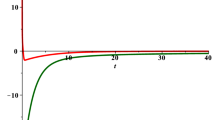Abstract
The well-known Generalized Champagne Problem on simultaneous stabilization of linear systems is solved by using complex analysis and Blondel’s technique. We give a complete answer to the open problem proposed by Patel et al., which automatically includes the solution to the original Champagne Problem. Based on the recent development in automated inequality-type theorem proving, a new stabilizing controller design method is established. Our numerical examples significantly improve the relevant results in the literature.
Similar content being viewed by others
References
Blondel V. Simultaneous Stabilization of Linear Systems. In: Lect Notes Contr Inf, Vol. 191. London: Springer-Verlag, 1994
Doyle J, Francis B, Tannenbaum A. Feedback Control Theory. New York: Macmillan Publishing Co., 1991
Vidyasagar M. Control System Synthesis: A Factorization Approach. Massachusetts: The MIT Press, 1985.
Saeks R, Murray J. Fractional representation, algebraic geometry and the simultaneous stabilization problem. IEEE T Automat Contr, 1982, 27(4): 895–903
Desoer C, Liu R, Murray J, et al. Feedback system design: the fractional representation approach to analysis and synthesis. IEEE T Automat Contr, 1980, 25(3): 399–412
Youla D, Bongiorno J, Jabr H. Modern Wiener-Hopf design of optimal controllers-part I: The single-input-output case. IEEE T Automat Contr, 1976, 21(1): 3–13
Youla D, Jabr H, Bongiorno J. Modern Wiener-Hopf design of optimal controllers-part II: The multivariable case. IEEE T Automat Contr, 1976, 21(3): 319–338
Kucera V. Discrete Linear Control: The Polynomial Equation Approach. New York: Wiley, 1979
Vidyasagar M, Viswanadham N. Algebraic design techniques for reliable stabilization. IEEE T Automat Contr, 1982, 27(5): 1085–1095
Youla D, Bongiorno J, Lu C. Single-loop feedback stabilization of linear multivariable plants. Automatica, 1974, 10(2): 159–173
Blondel V, Gevers M. Simultaneous stabilization of three linear systems is rationally undecidable. Math Control Signal, 1993, 6(2): 135–145
Blondel V, Gevers M, Mortini R, et al. Stabilizable by a stable and by an inverse stable but not by a stable and inverse stable. In: Proceedings of the 31st Conference on Decision and Control, Tucson, Arizons, 1992. 832–833
Blondel V, Gevers M, Mortini R, et al. Simultaneous stabilization of three or more systems: Conditions on the real axis do not suffice. SIAM J Control Optim, 1994, 32(2): 572–590
Blondel V, Sontag E D, Vidyasagar M, et al. Open Problems in Mathematical Systems and Control Theory. London: Springer-Verlag, 1999
Patel V V. Solution to the “Champagne Problem” on the simultaneous stabilization of three plants. Syst Contr Lett, 1999, 37(3): 173–175
Patel V V, Deodhare G, Viswanath T. Some applications of randomized algorithms for control system design. Automatica, 2002, 38(12): 2085–2092
Leizarowitz A, Kogan J, Zeheb E. On simultaneous stabilization of linear plants. Lat Am Appl Res, 1999, 29(3–4): 167–174
Ahlfors L. Conformal Invariants: Topics in Geometric Function Theory (McGraw-Hill Series in Higher Mathematics). New York: McGraw-Hill Book Company, 1973
Conway J. Functional of One Complex Variable. 2nd ed. New York: Springer-Verlag, 1978
Glouzin G. Geometric theory of functions of a complex variable. In: Translation of Math. Monographs, Vol. 26. American Math. Society, 1969
Nehari Z. Conformal Mapping. New York: McGraw-Hill Book Company, 1952
Rudin W. Real and Complex Analysis. 3rd ed. New York: McGraw-Hill Company, 1987
Yang L. A dimension-decreasing algorithm with generic program for automated inequalities proving. High Tech Lett (in Chinese), 1998, 8(7): 20–25
Yang L. Recent advances in automated theorem proving on inequalities. J Comput Sci Tech, 1999, 14(5): 434–446
Yang L, Hou X R, Xia B C. A complete algorithm for automated discovering of a class of inequality-type theorems. Sci China Ser F-Inf Sci, 2001, 44(1): 33–49
Yang L, Xia B C. Real solution classifications for parametric semi-algebraic systems. In: Dolzmann A, Seidl A, Sturm T, eds. Algorithmic Algebra and Logic, Proceedings of the A3L 2005, Herstellung und Verlag, Norderstedt, 2005, 281–289
Yang l, Xia S H. Automated proving for a class of constructive geometric inequalities, Chinese J Comput (in Chinese), 2003, 26(7): 769–778
Gantmacher F. Matrix Theory. New York: Chelsea, 1959
Yang L, Zhang J Z, Hou X R. Non-linear equations systems and automated theorem proving, Series in Nonlinear Sciences (in Chinese). Shanghai: Shanghai Press of Science, Technology, and Education, 1996
Tarski A. A Decision Method for Elementary Algebra and Geometry. Berkeley: The University of California Press, 1951
Anderson B, Bose N, Jury E. Output feedback stabilization and related problems — solution via decision methods. IEEE T Automat Contr, 1975, 20(1): 53–66
Wu W T. On the decision problem and mechanization of theorem-proving in elementary-geometry. Sci China, 1978, (21): 159–172
Wu W T. Mechanical Theorem Proving in Geometries: Basic Principles (translated from the Chinese by Jin X, Wang D). New York: Springer-Verlag, 1984
Wu W T. Mathematics mechanization, Series in Mathematics Mechanization (in Chinese). Beijing: Science Press, 2003
Arnon D S, Collins G E, McCallum S. Cylindrical algebraic decomposition I: The basic algorithm. SIAM J Comput, 1984, 13(4): 865–877
Arnon D S, Collins G E, McCallum S. Cylindrical algebraic decomposition II: An adjacency algorithm for the plane. SIAM J Comput, 1984, 13(4): 878–889
Collins G E, Hong H. Partial cylindrical algebraic decomposition for quantifier elimination. J Symb Comput, 1991, 12(3): 299–328
Yang L, Hou X R, Zeng Z B. A complete discrimination system for polynomials. Sci China Ser E-Tech Sci, 1996, 39(6): 628–646
Nie Y Y. Criteria for the stability of polynomials. Mechanics (in Chinese), 1976, (2): 110–116
Wu W T. On a finiteness theorem about problem involving inequalities. Syst Sci Math Sci, 1994, 7(2): 193–200
Author information
Authors and Affiliations
Corresponding author
Additional information
Supported by the National Natural Science Foundation of China (Grant Nos. 60572056, 60528007, 60334020, 60204006, 10471044, and 10372002), the National Key Basic Research and Development Program (Grant Nos. 2005CB321902, 2004CB318003, 2002CB312200), the Overseas Outstanding Young Researcher Foundation of Chinese Academy of Sciences and the Program of National Key Laboratory of Intelligent Technology and Systems of Tsinghua University
Rights and permissions
About this article
Cite this article
Guan, Q., Wang, L., Xia, B. et al. Solution to the Generalized Champagne Problem on simultaneous stabilization of linear systems. SCI CHINA SER F 50, 719–731 (2007). https://doi.org/10.1007/s11432-007-0053-2
Received:
Accepted:
Issue Date:
DOI: https://doi.org/10.1007/s11432-007-0053-2




